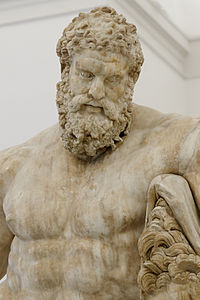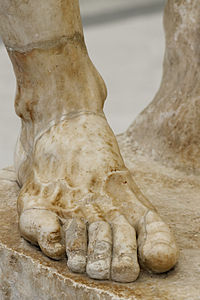Farnese Hercules
| Farnese Hercules | |
|---|---|
Museo Archeologico Nazionale, Naples |
The Farnese Hercules (

The Farnese Hercules is a massive marble statue, following a lost original that was
The type was well known in antiquity, and among many other versions a Hellenistic or Roman bronze reduction, found at
Description
Hercules is depicted in a moment of rest, but full of strength. Leaning on his gnarled club, which is draped in the skin of the Nemean lion, he holds the golden apples stolen from the Hesperides, hiding them behind his back, in his right hand.[6]
- Details
-
Face
-
Left arm leaning on the club
-
Right foot
History
The rediscovered statue quickly made its way into the collection of
The sculpture has been reassembled and restored by degrees. According to a letter of
Hercules is caught in a rare moment of repose. Leaning on his knobby club which is draped with the pelt of the

The sculpture was admired from the start, reservations about its exaggerated musculature only surfacing in the later eighteenth century.[8] Napoleon remarked to Antonio Canova that its omission from the museum he accumulated in Paris was the most important gap in the collection. More than once, the sculpture was crated and made ready for shipment to Paris before the Napoleonic regime fled Naples.
List of other ancient copies
The prominently sited statue was well liked by the Ancient Romans, and copies have been found in Roman palaces and gymnasiums: another, coarser copy stood in the courtyard of Palazzo Farnese; one with the feigned (but probably ancient) inscription "Lykippos" has stood in the court of Palazzo Pitti, Florence, since the sixteenth century. Ancient copies of the statue include:
- Hercules, 2nd century AD, Roman copy, Uffizi Gallery, Florence.
- The "Weary Herakles" is a heavily broken Roman marble statue that was excavated in 1980 in Perge, Turkey. The looted upper torso was sold to the Museum of Fine Arts, Boston, in 1981. The upper torso was returned to Turkey in 2011 and is now displayed with the rest of the piece at the Antalya Museum.[9]
- Colossal statue of Hercules, uncovered at the baths in Hippo Regius (Annaba), Algeria.
- Resting Herakles, Hermitage, Saint Petersburg.
- Heracles of Antikythera; badly damaged late Hellenistic Parian marble headless statue, recovered from the Antikythera Shipwreck in 1901 Athens, National Archaeological Museum.
- Headless statue at Izmit Archaeology and Ethnography Museum.
- Broken headless torso found in the bathhouse Roman & Byzantine village in the Jezreel valley.
- Broken headless torso from the Amphiareion of Oropos, Athens, National Archaeological Museum.
- Broken headless torso of 2nd or 3rd century AD, in Museum of Saint-Raymond in Toulouse.
- Statuette of 2nd century AD, in Detroit Institute of Arts.
- Bronze statuette with silver-inlaid eyes of 40–70 AD, Getty Villa.
Later copies
After rediscovery of the Farnese Hercules, copies appeared in sixteenth and eighteenth-century gardens throughout Europe. During construction of the
The statue is shown in the 1954 film Journey to Italy along with the Farnese Bull.
A replica, titled Herakles in Ithaca, was erected in 1989 on the campus of
The statue has inspired artists such as Jeff Koons and Matthew Darbyshire to create their own versions in plaster and polystyrene, respectively.[12] Their use of white materials to re-create the sculpture has been interpreted by classicist Aimee Hinds as a perpetuation of colourism in classical art.[12]
A copy of the sculpture is among the ten statues adorning the front yard of the Schlossgarten in Karlsruhe, Germany.
References
Notes
| External videos | |
|---|---|
 | |
- ^ Harry Thurston Peck, Harpers Dictionary of Classical Antiquities (1898), Glycon
- ^ Cast of the Farnese Hercules, c.1790 - Royal Academy of Arts
- ^ Bieber 1961; Robertson 1975. On the original and its copies, see Krull 1985.
- ^ The chronicler Ulisse Aldrovandi, 1556.
- ^ Haskell & Penny 1981, pp. 229–32
- ^ Schneider 2005, pp. 142–150
- ^ Haskell & Penny 1981, p. 229
- ^ Haskell & Penny 1981
- ^ Weary Herakles, Trafficking Culture, 31-Dec-2011.
- ^ Albardonedo Freire 1999a; Albardonedo Freire 1999b; Albardonedo Freire 2002
- ^ Klein, Kate (October 27, 2016). "Iconic sculpture Herakles returns to plinth, thanks to gift". Cornell Chronicle. Retrieved March 14, 2019.
- ^ a b Hinds, Aimee. "Hercules in White: Classical Reception, Art and Myth". The Jugaad Project. Retrieved 2020-10-22.
- ^ "Lysippos, Farnese Hercules". Smarthistory at Khan Academy. Archived from the original on October 16, 2014. Retrieved February 18, 2013.
Bibliography
- Albardonedo Freire, Antonio J. (1999a). "Carlos V en la Alameda de Sevilla". Actas de las IX Jornadas Nacionales de Historia Militar (9). Sevilla. Cátedra General Castaños. Capitanía General de la Región Militar del Sur: 13–18. ISBN 84-86379-53-9.
- Albardonedo Freire, Antonio J. (1999b). "Las Trazas y Construcciones de la Alameda de Hercules". Laboratorio de Arte. 11: 135–165.
- Albardonedo Freire, Antonio (2002). El Urbanismo de Sevilla durante el reinado de Felipe II. Sevilla: Guadalquivir Ediciones. pp. 191–208. ISBN 84-8093-115-9.
- Bieber, Margarete (1961). The Sculpture of the Hellenistic Age (revised ed.). New York.
{{cite book}}: CS1 maint: location missing publisher (link) - Bober, Phyllis; Rubinstein, Ruth (1986). Renaissance Artists and Antique Sculpture.
- Haskell, Francis; Penny, Nicholas (1981). Taste and the Antique: The Lure of Classical Sculpture, 1500–1900. New Haven: Yale University Press. pp. 229–32. Catalogue no. 46.
- Krull, Diethelm (1985). Der Herakles vom Typ Farnese. Kopienkritische Untersuchung einer Schöpfung des Lysipp. Frankfurt am Main.
{{cite book}}: CS1 maint: location missing publisher (link) - Robertson, Martin (1975). A History of Greek Art. Cambridge.
{{cite book}}: CS1 maint: location missing publisher (link) - Schneider, Rolf Michael (2005). "Der Hercules Farnese". In Giuliani, Luca (ed.). Meisterwerke der antiken Kunst. München. pp. 136–157.
{{cite book}}: CS1 maint: location missing publisher (link)



